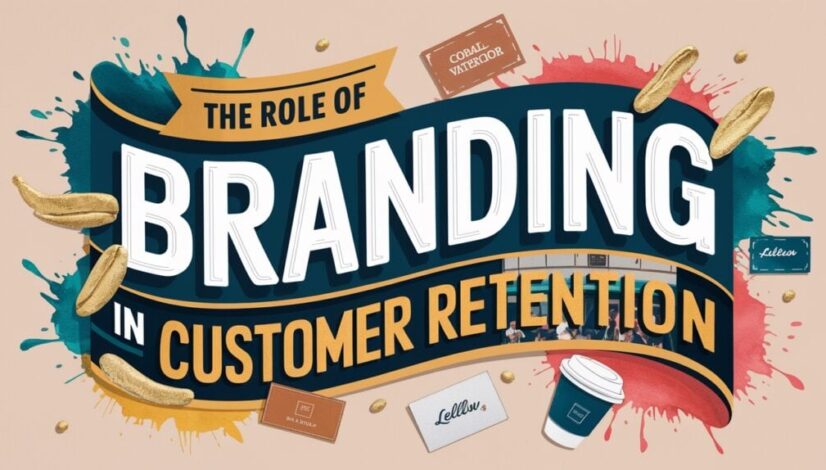The Role of Branding in Customer Retention
Branding plays an essential role in customer retention by creating emotional connections that foster loyalty. A strong brand identity aligns with consumer expectations, enhancing trust and engagement. Consistency in messaging and visual identity strengthens customer relationships, while authentic storytelling deepens emotional ties. By differentiating themselves in a competitive market, brands can maintain loyalty through personalized experiences and community involvement. Additionally, regular feedback enables brands to evolve and adapt, ensuring they remain relevant. Together, these elements solidify customer attachment, driving sustained retention and advocacy. To uncover deeper insights on the dynamics of branding, one simply needs to explore further.
Key Takeaways
- Branding creates emotional connections that foster customer loyalty and enhance long-term retention.
- Consistent brand messaging and identity build trust and reinforce customer relationships.
- Authenticity in branding, through transparency and ethical practices, strengthens brand reputation and consumer trust.
- Engaging storytelling captivates audiences, enhancing brand loyalty through relatable narratives.
- Customer feedback drives brand evolution, ensuring offerings align with changing consumer expectations and preferences.
Importance of Branding

Branding serves as an essential cornerstone in the architecture of customer retention, embodying the essence of a company’s identity and values. The significance of branding transcends mere recognition; it cultivates brand loyalty by aligning a company’s visual identity with the expectations and desires of its target audience. A robust brand strategy enhances market perception, establishing a framework that shapes how consumers view and engage with a brand.
Emotional branding plays a crucial role in this dynamic, as it fosters a deeper connection between the consumer and the brand, ultimately enriching the customer experience. This connection is not merely transactional; it nurtures a sense of belonging and community, which is critical for sustained brand advocacy.
In addition, effective branding elevates brand equity, ensuring that consumers not only recognize a brand but also prefer it over competitors. Strategic positioning is important, as it helps a brand carve out its niche within the marketplace, enhancing brand awareness and resonating with culturally relevant narratives.
In doing so, it addresses the diverse needs of consumers while reinforcing the brand’s commitment to its core values. Ultimately, branding is not an isolated function but an integral part of a company’s operational strategy.
Emotional Connection With Customers
Establishing an emotional connection with customers is essential for fostering loyalty and retention, and it begins with building trust through authenticity.
By leveraging storytelling and a consistent brand identity, businesses can resonate deeply with their audience, creating a sense of belonging and shared values.
This strategic approach not only enhances customer engagement but also solidifies long-term relationships that are vital for sustained success.
Building Trust Through Authenticity
Trust serves as the cornerstone of any successful relationship between a brand and its customers, and authenticity is the key that opens this essential connection. During a time when consumers are increasingly discerning, brand authenticity becomes a vital differentiator. Companies that prioritize ethical branding practices not only enhance their brand reputation but also foster deep consumer trust.
By delivering authentic experiences, these brands create a foundation for brand loyalty that transcends mere transactional interactions. Trust signals, such as transparency in sourcing and honest communication, solidify this relationship, allowing customers to feel secure in their choices.
When consumers perceive a brand as genuinely committed to its values, they are more likely to engage in customer advocacy, championing the brand within their networks. This advocacy stems from an emotional connection established through shared principles and experiences.
Moreover, brands must continually assess and adapt their strategies to guarantee that their authenticity is both perceived and experienced by consumers. Those who succeed in this endeavor reap the rewards of unwavering brand loyalty, as customers are drawn to brands that resonate with their values.
Ultimately, building trust through authenticity is not just a strategy; it is a necessity for sustainable customer retention.
Storytelling and Brand Identity
As consumers navigate an increasingly crowded marketplace, the power of storytelling emerges as a pivotal tool for brands seeking to forge emotional connections. A compelling brand narrative not only captivates audiences but also enhances customer loyalty by creating a shared identity.
By employing visual storytelling and brand archetypes, brands can evoke cultural resonance, effectively tapping into the collective psyche of their target demographics.
To achieve this, brands must prioritize:
- Emotional Branding: Forge connections through relatable emotions that resonate deeply with consumers.
- Brand Mythology: Develop a rich narrative that encapsulates the brand’s journey, values, and mission.
- Narrative Consistency: Guarantee that all brand communications align with the core story, reinforcing trust and authenticity.
- Immersive Experiences: Create engaging interactions that allow customers to experience the brand narrative firsthand.
- Brand Voice: Maintain a distinct and cohesive tone that reflects the brand’s personality throughout the customer journey.
Brand Consistency Matters

In the domain of customer retention, the importance of brand consistency cannot be overstated. Consistency in branding serves as a cornerstone for establishing a robust brand reputation, which is pivotal in fostering brand loyalty. When customers encounter a unified visual identity across all touchpoints—be it packaging, advertising, or customer service—they are more likely to trust the brand, enhancing their overall customer experience.
Brand awareness is greatly influenced by consistent messaging and visuals. This coherence not only solidifies market positioning but also reinforces brand values, allowing consumers to resonate with the principles the brand stands for.
Moreover, emotional branding thrives on consistency; when brands deliver a predictable experience, they evoke specific emotions that strengthen consumer attachments.
Incorporating community involvement into brand strategies enhances this consistency. When brands engage in local initiatives or social causes, they echo their brand values, thereby reinforcing the emotional connection with their audience.
Experiential marketing efforts must also align with the established brand narrative to guarantee that customers perceive an integrated experience, regardless of the platform.
Ultimately, maintaining brand consistency is not merely a tactical approach; it is a strategic imperative that cultivates a loyal customer base. As brands navigate an ever-evolving marketplace, those that prioritize consistency will not only protect their reputation but also thrive through enhanced brand loyalty and customer retention, assuring they remain top-of-mind in an increasingly competitive landscape.
Building Trust Through Authenticity
In today’s competitive landscape, building trust through authenticity is paramount for effective customer retention.
By prioritizing transparency in communication, maintaining consistent brand messaging, and employing genuine engagement strategies, brands can foster deeper connections with their audience.
This authenticity not only enhances customer loyalty but also positions the brand as a reliable partner in their customers’ journeys.
Transparency in Communication
While businesses often focus on branding strategies to attract new customers, the significance of transparency in communication cannot be overstated when it comes to fostering long-term loyalty.
Transparent communication cultivates an environment where trust flourishes. By prioritizing open dialogue and authentic interactions, brands can create a strong emotional connection with their customers. This connection is reinforced through proactive updates and clear messaging, which empower customers with accessible information.
Key practices that enhance transparency include:
- Open Dialogue: Encouraging two-way communication, allowing customers to share their thoughts.
- Proactive Updates: Regularly informing customers about changes and developments.
- Clear Messaging: Ensuring that all communications are straightforward and easy to understand.
- Honest Feedback: Actively seeking and valuing customer input to improve products and services.
- Transparent Policies: Clearly outlining return, privacy, and service policies to eliminate confusion.
Consistent Brand Messaging
Consistent brand messaging serves as a cornerstone for building trust and authenticity in customer relationships. By ensuring alignment between brand voice and messaging strategies across all communication channels, organizations can cultivate a cohesive brand personality that resonates with their target audience.
This consistency not only reinforces market positioning but also enhances visual identity, making brands more recognizable and relatable.
Moreover, effective audience segmentation allows brands to tailor their messaging while maintaining tone consistency, ensuring that cultural relevance is preserved. When customers perceive a brand as authentic and trustworthy, they are more likely to remain loyal, fostering long-term relationships.
To achieve this, brands must develop a strategic approach that integrates messaging alignment with their core values and mission. This involves not only crafting compelling narratives but also utilizing varied communication mediums effectively to reach diverse customer segments.
Ultimately, consistent brand messaging is not merely about repetition; it is about creating a unified experience that reflects the brand’s essence. When executed thoughtfully, it builds a foundation of trust that encourages customers to engage, advocate, and remain loyal to the brand over time.
Genuine Engagement Strategies
Fostering authentic connections with customers hinges on genuine engagement strategies that prioritize transparency and relatability. During a time when consumers are increasingly discerning, brands must leverage authentic interactions to build trust and enhance customer retention. This involves not only aligning with customer values but also actively involving them in the brand narrative.
To effectively implement genuine engagement strategies, brands should consider the following:
- Community Involvement: Participate in local initiatives to strengthen brand loyalty.
- Personalized Experiences: Tailor interactions based on individual preferences to foster deeper connections.
- User Generated Content: Encourage customers to share their experiences, amplifying authenticity.
- Feedback Loops: Create systems for continuous customer feedback to refine offerings and enhance satisfaction.
- Brand Ambassadors: Empower loyal customers to represent the brand, reinforcing trust through shared values.
Engaging Customers Effectively

Effective customer engagement is a cornerstone of successful branding, with studies indicating that companies prioritizing engagement see up to a 20% increase in customer retention rates. This engagement hinges on enhancing the customer experience through personalized interactions that resonate emotionally.
Personalization transforms mundane transactions into meaningful exchanges, fostering a connection that encourages loyalty and repeat business.
Social media engagement plays a pivotal role in this dynamic, allowing brands to create real-time dialogues with customers. By leveraging platforms where audiences congregate, companies can facilitate community building, turning customers into brand advocates.
These advocates amplify brand messages through user-generated content, which not only enriches the brand narrative but also builds trust among potential customers.
Loyalty programs can further enhance engagement by rewarding customers for their patronage, creating a continuous feedback loop that informs brands about customer preferences. This data-driven approach allows for the refinement of experiential marketing efforts, ensuring that campaigns resonate on a personal level.
For instance, hosting exclusive events or providing personalized offers can lead to emotional resonance, reinforcing a sense of belonging and commitment among customers.
Ultimately, effective customer engagement is about cultivating a holistic experience that combines various strategies—from loyalty programs to social media initiatives.
Differentiation in a Competitive Market
In a landscape where customer engagement is increasingly essential, brands must also emphasize differentiation to stand out amidst fierce competition. The ability to carve a unique niche is critical for sustaining customer loyalty and enhancing retention. This necessitates well-crafted brand positioning strategies that not only resonate with target audiences but also align with their evolving needs and preferences.
Differentiation allows brands to establish a competitive advantage, which can be effectively articulated through a robust competitive advantage analysis. This process enables companies to identify unique selling propositions that can set them apart from competitors.
To achieve this, brands should consider the following key elements:
- Value Proposition: Clearly define what makes the brand unique and valuable to the customer.
- Customer Experience: Enhance interactions at every touchpoint to foster loyalty and satisfaction.
- Innovation: Regularly introduce new products or services that reflect market trends and customer desires.
- Brand Authenticity: Communicate genuine values and missions that resonate with consumers, fostering trust and loyalty.
- Target Audience Understanding: Utilize data-driven insights to cater to the specific preferences and behaviors of the target demographic.
The Role of Storytelling

Three essential elements of branding—connection, engagement, and loyalty—are profoundly influenced by the art of storytelling. At the heart of effective storytelling lies the use of narrative techniques that captivate audiences and create emotional resonance. Brands that employ these techniques can forge deep connections with customers, transforming mere transactions into lasting relationships.
By leveraging brand archetypes, companies can shape their narratives to align with the values and aspirations of their target audience, thereby enhancing customer journeys. Each archetype serves as a framework for character development, allowing brands to craft relatable figures that resonate with consumers on a personal level. This connection is further enriched through visual storytelling, where imagery amplifies the narrative, creating immersive experiences that engage the senses.
Moreover, brand folklore and cultural narratives play a significant role in embedding a brand within the larger societal context. By integrating these elements, brands can position themselves as part of a shared cultural experience, fostering a sense of belonging among customers. As consumers immerse themselves in these stories, they become emotionally invested, which is vital for cultivating loyalty.
Through the creation of compelling brand legends, organizations can narrate their history, mission, and values in a way that captivates and inspires. As customers relate to these stories, they are more likely to remain loyal, reinforcing the brand’s presence in their lives.
Ultimately, storytelling is not merely a marketing tool; it is a strategic imperative that drives customer retention and fosters an enduring brand legacy.
Customer Feedback and Brand Evolution
Customer feedback serves as a vital compass for brand evolution, guiding companies toward more resonant and relevant offerings. During a time when consumer expectations are continually shifting, harnessing insights from customer surveys and establishing robust feedback loops are essential strategies for brand adaptation.
This ongoing dialogue not only enriches the understanding of user experience but also propels brand innovation, aligning products and services with the latest market trends.
The dynamic nature of customer feedback provides a wealth of consumer insights that can drastically influence brand perception. By actively integrating this feedback into operational practices, companies can create loyalty programs that resonate deeply with their audience.
This proactive approach fosters stronger emotional connections, ultimately enhancing customer retention.
Key elements of effective feedback integration include:
- Regular customer surveys to capture evolving preferences and needs.
- Feedback loops that guarantee continuous improvement based on consumer reactions.
- Brand adaptation to swiftly respond to shifts in market trends and expectations.
- Enhancing user experience by implementing changes that directly address customer concerns.
- Innovating the brand to stay competitive while remaining true to core values.
Incorporating these elements positions brands not only to meet but to exceed customer expectations, thereby solidifying loyalty and enhancing overall brand equity.
As businesses evolve, recognizing the value of customer feedback will be paramount in maintaining relevance and heightening brand appeal in a competitive landscape.
Measuring Branding Success

Understanding customer feedback is only the beginning; organizations must also establish metrics to gauge the effectiveness of their branding strategies. Measuring branding success involves a multidimensional approach, where brand metrics serve as the compass guiding an organization’s efforts.
The first critical metric is brand awareness, which quantifies how familiar consumers are with a brand. High levels of awareness are often directly correlated with increased brand equity, as they lay the groundwork for deeper customer engagement.
Brand perception and brand experience further enrich the analysis, allowing organizations to assess how their brand is viewed in the marketplace. Positive brand perceptions can enhance brand loyalty, creating a cycle where satisfied customers advocate for the brand—this is where brand advocacy becomes a powerful asset.
Organizations must actively monitor these perceptions through surveys and social listening tools to guarantee alignment with their core values and customer expectations.
Moreover, aligning branding efforts with customer experiences can amplify brand loyalty, guaranteeing that consumers not only recognize the brand but also feel a connection to it. This alignment is critical in maintaining a consistent brand narrative that resonates across all touchpoints.
Ultimately, by leveraging these metrics—brand equity, brand loyalty, brand awareness, brand perception, brand advocacy, and brand experience—organizations can create a thorough framework that not only measures success but also drives continuous improvement in their branding strategies, guaranteeing long-term customer retention and loyalty.
Frequently Asked Questions
How Can Small Businesses Implement Effective Branding Strategies?
Small businesses can implement effective branding strategies by developing a compelling visual identity that resonates with their target audience. This includes creating a cohesive logo, color palette, and typography that reflect the brand’s values.
Additionally, leveraging brand storytelling can engage customers emotionally, fostering loyalty and connection. By articulating their unique narrative, small businesses can differentiate themselves in a competitive market, ultimately enhancing brand recognition and encouraging repeat patronage.
What Are Common Branding Mistakes to Avoid?
A staggering 70% of consumers report that they perceive inconsistent messaging from brands as a major deterrent to engagement.
To avoid common branding mistakes, businesses must prioritize consistent communication across all platforms.
Additionally, neglecting the audience’s preferences and feedback can lead to alienation.
How Often Should a Brand Refresh Its Image?
A brand should refresh its image periodically to align with market shifts and consumer expectations.
Typically, every three to five years is advisable, allowing for brand evolution while maintaining core values.
This refresh should focus on updating visual identity elements, such as logos and color schemes, to reflect contemporary aesthetics and relevance.
A strategic approach guarantees the brand remains distinctive and engaging, fostering deeper connections with its audience while avoiding stagnation.
Can Branding Influence Pricing Strategies?
In the domain of commerce, the right price can make or break a sale, much like the saying goes, “You get what you pay for.”
Branding profoundly shapes brand perception, allowing companies to command higher prices through perceived value. By leveraging pricing psychology, brands can strategically position themselves in the market, aligning their prices with consumer expectations and emotional responses.
Consequently, effective branding not only influences customer loyalty but also enhances pricing strategies.
What Role Does Social Media Play in Branding?
Social media serves as a pivotal platform for shaping a brand’s visual identity and fostering audience engagement.
Through carefully curated content, brands can communicate their values and aesthetics, establishing a distinctive presence that resonates with target demographics.
Moreover, interactive features enable real-time dialogue, enhancing customer relationships and loyalty.
Conclusion
In the domain of customer retention, branding emerges as a pivotal force. As the adage goes, “A good name is better than riches,” underscoring the significance of a strong brand identity. By fostering emotional connections, ensuring consistency, and promoting authenticity, brands can build trust and loyalty. Additionally, effective engagement and differentiation in a competitive landscape enhance customer experiences. Ultimately, a well-executed branding strategy not only retains customers but also evolves with their needs, ensuring long-term success.




